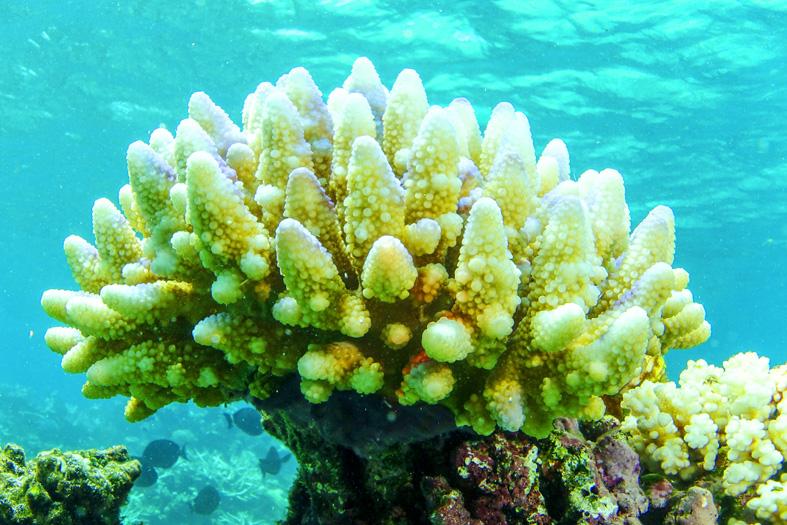Parts of Australia’s Great Barrier Reef now have the highest levels of coral cover in decades, an Australian government report said yesterday.
Portions of the UNESCO heritage site showed a marked increase in coral cover in the past year, reaching levels not seen in 36 years of monitoring, the Australian Institute of Marine Science said.
Scientists surveying 87 sites said that northern and central parts of the reef had bounced back from damage more quickly than some had expected, thanks mainly to fast-growing Acropora — a branching coral that supports thousands of marine species.

Photo: AP
“These latest results demonstrate the reef can still recover in periods free of intense disturbances,” Australian Institute of Marine Science chief executive officer Paul Hardisty said.
Far from declaring victory, Hardisty warned that the gains could easily be reversed by cyclones, new bleaching events or crown-of-thorns outbreaks.
He pointed to a reversal in fortunes for the southern portion of the reef, which a year ago had appeared to be on the mend, but was now in decline again.
“This shows how vulnerable the reef is to the continued acute and severe disturbances that are occurring more often, and are longer-lasting,” he said.
Coral coverage has increased by 36 percent across sites monitored in the northern part of the reef, up from 27 percent last year.
However, the picture was less encouraging as the scientists moved south, with a smaller increase in cover in the reef’s central belt and a marked decrease in coral cover in the south.
The spread of coral-killing crown-of-thorns starfish has also taken a toll.
Only lobbying by the Australian government stopped the reef from being labeled “in danger” by UNESCO — a potentially devastating blow to the tourism industry.
Many fear that the speeding rate of damage could cause the reef to be destroyed entirely.
Marine scientist Terry Hughes said it was “good news” that coral was regrowing, but warned that the species driving the recovery were vulnerable to ocean warming.
Replacing large, old, slow-growing corals that had defined the reef was likely “no longer possible,” Hughes said.
“Instead we’re seeing partial reassembly of fast-growing, weedy corals before the next disturbance,” he said.
Zoe Richards, a researcher at the Coral Conservation and Research Group at Curtin University, also cautioned against over-optimism.
“This recovery trend is driven by a handful of Acropora species, which often grow in a boom-and-bust pattern,” Richards said. “This means that the next thermal stress event could easily decimate these coral communities once again.”
“We are already finding evidence that each mass bleaching event leads to local extinctions of rarer species, so the short-term success of a handful of fast-growing coral species masks the full story about the largely hidden losses of biodiversity,” she said.

The death of a former head of China’s one-child policy has been met not by tributes, but by castigation of the abandoned policy on social media this week. State media praised Peng Peiyun (彭珮雲), former head of China’s National Family Planning Commission from 1988 to 1998, as “an outstanding leader” in her work related to women and children. The reaction on Chinese social media to Peng’s death in Beijing on Sunday, just shy of her 96th birthday, was less positive. “Those children who were lost, naked, are waiting for you over there” in the afterlife, one person posted on China’s Sina Weibo platform. China’s

‘NO COUNTRY BUMPKIN’: The judge rejected arguments that former prime minister Najib Razak was an unwitting victim, saying Najib took steps to protect his position Imprisoned former Malaysian prime minister Najib Razak was yesterday convicted, following a corruption trial tied to multibillion-dollar looting of the 1Malaysia Development Berhad (1MDB) state investment fund. The nation’s high court found Najib, 72, guilty on four counts of abuse of power and 21 charges of money laundering related to more than US$700 million channeled into his personal bank accounts from the 1MDB fund. Najib denied any wrongdoing, and maintained the funds were a political donation from Saudi Arabia and that he had been misled by rogue financiers led by businessman Low Taek Jho. Low, thought to be the scandal’s mastermind, remains

‘POLITICAL LOYALTY’: The move breaks with decades of precedent among US administrations, which have tended to leave career ambassadors in their posts US President Donald Trump’s administration has ordered dozens of US ambassadors to step down, people familiar with the matter said, a precedent-breaking recall that would leave embassies abroad without US Senate-confirmed leadership. The envoys, career diplomats who were almost all named to their jobs under former US president Joe Biden, were told over the phone in the past few days they needed to depart in the next few weeks, the people said. They would not be fired, but finding new roles would be a challenge given that many are far along in their careers and opportunities for senior diplomats can

Australian Prime Minister Anthony Albanese yesterday announced plans for a national bravery award to recognize civilians and first responders who confronted “the worst of evil” during an anti-Semitic terror attack that left 15 dead and has cast a heavy shadow over the nation’s holiday season. Albanese said he plans to establish a special honors system for those who placed themselves in harm’s way to help during the attack on a beachside Hanukkah celebration, like Ahmed al-Ahmed, a Syrian-Australian Muslim who disarmed one of the assailants before being wounded himself. Sajid Akram, who was killed by police during the Dec. 14 attack, and